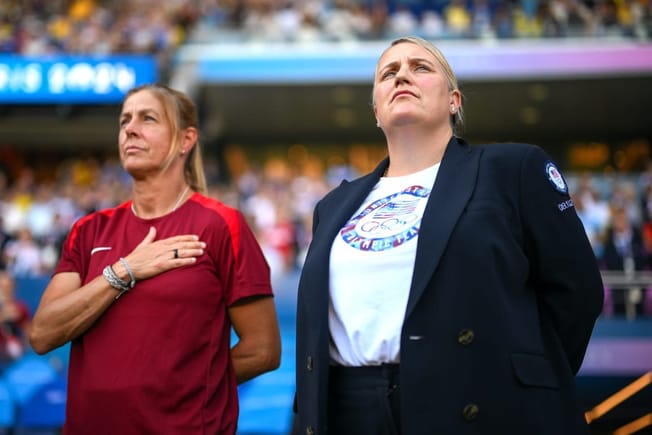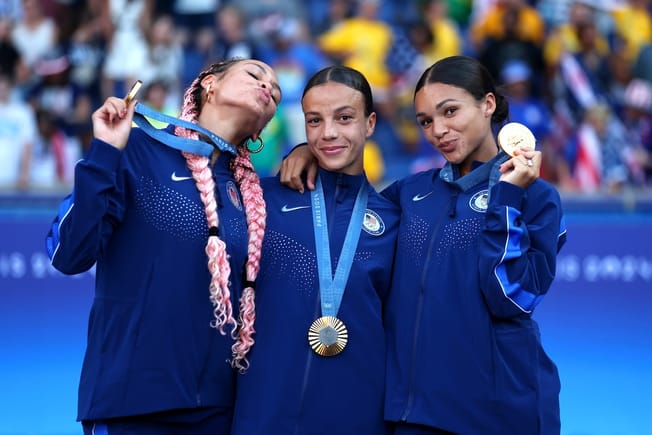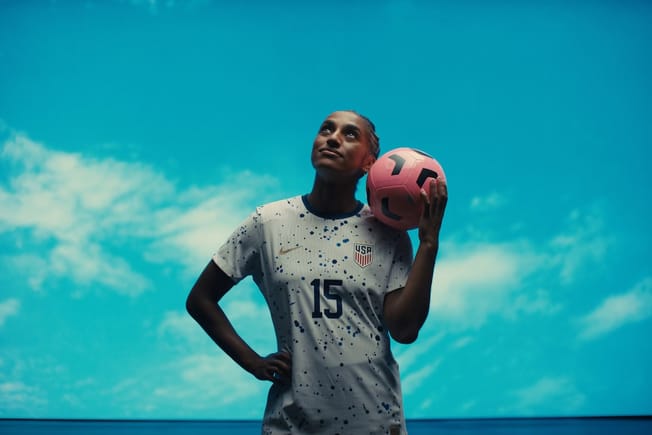It wasn’t pretty, but the U.S. finished the group stage at the Concacaf W Championship with a 1-0 win over Mexico on Monday night. That result helped the USWNT secure the top spot in Group A and set up a semifinal match against Costa Rica on Thursday.
Now that the group stage is over, what does the United States still need to do at the W Championship?
Let’s talk about that.
QUALIFY FOR THE OLYMPICS
Simple, right?
Qualifying for the Olympics was always one of the two results-based goals for the USWNT heading into this tournament down in Mexico. The other goal was to qualify for the World Cup, which the United States did after two games. To qualify for the 2024 Olympics, the U.S. needs to make it past Costa Rica in the semis and then take down their next opponent, likely Canada, in the final.
With all of the USWNT’s quality players, they’re more than capable of winning the W Championship and earning that auto-qualification spot for 2024. But being capable of winning this tournament isn’t enough. Making it to the final – and then winning it – is a must for the United States.
After finishing third at the Olympics last summer, these next two games are two of the biggest of Vlatko Andonovski’s tenure. Because the U.S. underperformed in Tokyo, it’s critical that they improve and get results over this next week.
Unfortunately for the U.S., Monday’s game against Mexico doesn’t give them much momentum. It was the worst of their three group stage games by some distance: there were far too many sloppy touches, poor passes, and questionable tactical choices. The United States’ only goal came late in the game once Mexico had already gone down to 10 players.
KRISTIE IN THE 89TH 🇺🇸🇺🇸🇺🇸pic.twitter.com/8RhSJz4pXJ
— U.S. Women's National Soccer Team (@USWNT) July 12, 2022
Overall, the game felt eerily similar to the USWNT’s matches at last year’s Olympics, albeit with much lower stakes. The U.S will need to be sharper and more consistent in the knockout rounds if they want to win this tournament.
TRUST THE NEW GUARD
It’s becoming increasingly clear that the United States’ new guard is ready to change games. That new guard includes an immensely talented group of young forwards (see: Mallory Pugh and Sophia Smith). It also includes creative midfielder Ashley Sanchez and up-and-coming center back Naomi Girma.
At least one, if not both, of the USWNT’s young wingers is going to start however many games the U.S. has left in Mexico. But setting the forward group aside, I think Andonovski should continue to start Sanchez in the midfield and Grima in the back in the knockout rounds.
Girma was strong defensively in both of her group stage starts, one against Jamaica and one against Mexico. Her patience and quick reads help her elevate the United States’ backline. More than that, she looks like an upgrade over Becky Sauerbrunn in pretty much every phase of play. I’m not sure if Andonovski would be willing to start Girma over Sauerbrunn, a U.S. legend, in big games at this tournament, but I think he should consider it.
And then there’s Sanchez.
Sanchez tries stuff, people. Her ambition on the ball, creativity in the attack, and defensive mobility make her an extremely valuable presence for the USWNT. She’s appeared in all three games for the U.S. so far, mostly playing as a No. 8, but also playing some as a No. 10 in a 4-2-3-1 against Mexico (more on that later). I don’t think it’s a coincidence that the U.S. had their best attacking performance against Jamaica when Sanchez and Rose Lavelle started together in central midfield.
At this point, Sanchez has shown that she should be starting as one of the No. 8s.
STAY AWAY FROM THE 4-2-3-1
Before this tournament, Andonovski mentioned that the United States might play with a “double six”. They did just that for long stretches against Mexico on Monday, with Andi Sullivan and Lindsey Horan sitting deeper in midfield.
The U.S. had the edge on Mexico, but they didn’t play well. The 4-2-3-1 shape (or, at the very least, a super lopsided 4-3-3 with Horan playing lower on the left and Sanchez playing higher on the right) and the USWNT’s execution in that shape was poor, to say the least. With both Sullivan and Horan sitting deep, there was a massive gap between the back four/double pivot and the front three/No. 10.
That gap forced Sullivan into too much distribution. In general, she struggled to control the game and her errant passing hurt the USWNT. As the game wore on, the U.S. primarily advanced the ball through long balls over the top from Sullivan and Horan, which didn’t lead to many meaningful chances. You can see that gap in midfield in this image, with Horan setting up for a ball over the top.

Looking a little higher up the field, Sanchez didn’t get enough touches playing as a No. 10 or even as a second forward next to Alex Morgan. Finally, because Andonovski flipped the central midfield shape and because the fullbacks were very reserved, there weren’t as many FB-CM-W combinations. As the clock ticked towards 90 minutes, the U.S. reverted to hopeful long balls and scattered play even against a 10-player defense.
With all of those attacking issues in mind, the United States should stay away from the 4-2-3-1 and go back to the 4-3-3 against Costa Rica.
If the U.S. can find their attacking rhythm and create consistent chances with the possession that most opposing teams give them, they’ll be in great shape. If not…we’ll all be reliving last summer’s Olympics.







Comments